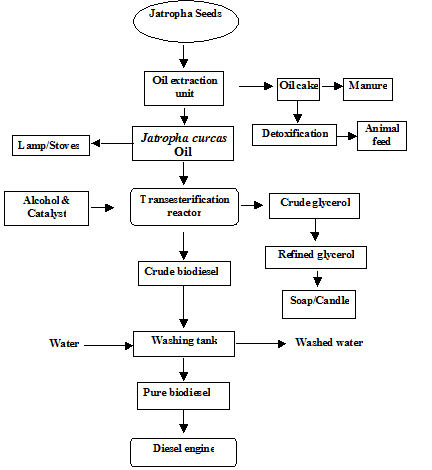TNAU Biodiesel Production Plant
Biodiesel production methods
Biodiesel is a clean renewable fuel and domestically produced from vegetable oil or waste oils. The major components of vegetable oils are triglycerides. Triglycerides are esters of glycerol with long chain acids, commonly known as fatty acids. Chemically, biodiesel refers to mono alkyl esters of long chain fatty acids derived from vegetable oils. The most common process for making biodiesel is known as transesterification. This process involves combining any vegetable or waste oil with any alcohol and a catalyst. Even though other processes are available for making biodiesel, this is the most commonly and commercially used one, because of its simplicity and efficiency.
Production technology of Biodiesel
TNAU biodiesel pilot plant
For the esterification of Jatropha oil, alkaline-based catalyst is used in this plant. The Jatropha oil is blended with alcohol and catalyst mixture. The oil extracted from the seeds of Jatropha is mixed with methanol catalyst mixture at a proportion under a particular temperature. This solution is continuously stirred for two hours. During the above process, glycerol present in the solution separate out, which when settled can be separated out. For settling, three separate tanks are provided in the plant. After removing the glycerol, the liquid biodiesel is transferred to washing tank, where the fuel is washed twice and the purified biodiesel is obtained.
Mechanics of the transesterification process
- Take 50 litres of Jatropha oil in the container and pump oil from inlet tank to biodiesel reactor by using inlet pump (10 minutes)
- Switch ON for heater of biodiesel reactor
- Take 20 per cent of methanol and 1 per cent of sodium hydroxide (by weight of oil) in the chemical mixing tank. Ensure that gate valve for chemical tank is in closed position before filling of methanol into tank
- Switch ON for stirrer of chemical mixing tank (15 minutes) to produce the sodium methoxide solution
- After reaching reaction temperature 60 deg. C, the sodium methoxide is send to biodiesel reactor by opening of gate valve and close the valve.
- Switch ON for main stirrer of biodiesel reactor and reaction is continued for about 2 hours
- After reaction time is completed, open the gate valve for glycerol settling tank and the biodiesel and glycerol mixer is send to the glycerol settling tank (by using storage switch)
- Allow the biodiesel mixture in glycerol settling tanks for 12 hours
- Before feeding of raw biodiesel, fill 100 litres of water in the washing tank
- Remove the glycerol from settling tank and biodiesel is sent to washing tank by opening gate
- Switch ON the aerator for 30 minutes. Allow the sample for 3 hours and remove the biodiesel from washing tank
- Heat the biodiesel for 20 minutes to remove the moisture.
Flow chart for Biodiesel Production
|

